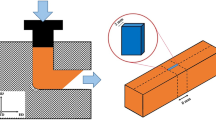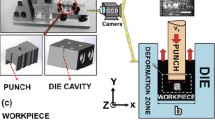Abstract
An unintended anisotropic deformation of a polycrystalline billet has been observed in micro-extrusion, which implies that the extruded billet shows a curved shape rather than an intended straight curve. Although the deformation is considered to originate from the anisotropy of crystal grains, three-dimensional computational analyses are yet to be conducted owing to computational challenges. In this study, the anisotropic deformation behavior of a polycrystalline billet during micro-extrusion was investigated by performing three-dimensional finite element analyses based on the anisotropic elastoplastic constitutive model of a single crystal and its robust algorithm. To explain the effect of grain size on the unintended deformation of billet in micro-extrusion, several simulations for two extrusion dies were performed considering polycrystalline billets containing crystal grains between 100 and 20,000 in number, and the results were statistically analyzed. Anisotropic deformation appeared in the billets with fewer grains, owing to the anisotropy of the single crystal. The grain size, normalized with respect to the billet diameter at which the anisotropic deformation began to appear, was quantitatively estimated. These results are in agreement with the corresponding experiments. Furthermore, simulation results indicated that the extruded crystallographic texture decreased the anisotropic deformation in the case of large grains.









Similar content being viewed by others
Availability of code and data
The code and data are available from the corresponding author upon request.
References
Kuwabara T, Ikeda S, Kuroda K (1998) Measurement and analysis of differential work hardening in cold-rolled steel sheet under biaxial tension. J Mater Process Technol 80–81:517–523. https://doi.org/10.1016/S0924-0136(98)00155-1
Li Q, Zhang H, Chen F et al (2020) Study on the plastic anisotropy of advanced high strength steel sheet: Experiments and microstructure-based crystal plasticity modeling. Int J Mech Sci 176:105569. https://doi.org/10.1016/j.ijmecsci.2020.105569
Hill R (1948) A theory of the yielding and plastic flow of anisotropic metals. Proc R Soc Lond A 193:281–297. https://doi.org/10.1098/rspa.1948.0045
Gotoh M (1977) A theory of plastic anisotropy based on yield function of fourth order (plane stress state) - I. Int J Mech Sci 19:505–512. https://doi.org/10.1016/0020-7403(77)90043-1
Gotoh M (1977) A theory of plastic anisotropy based on yield function of fourth order (plane stress state) - II. Int J Mech Sci 19:513–520. https://doi.org/10.1016/0020-7403(77)90044-3
Barlat F, Aretz H, Yoon JW et al (2005) Linear transformation-based anisotropic yield functions. Int J Plast 21:1009–1039. https://doi.org/10.1016/j.ijplas.2004.06.004
Amaishi T, Tsutamori H, Nishiwaki T et al (2020) Description of anisotropic properties of sheet metal based on spline curves and hole expansion test simulation of high-strength steel. Int J Solids Struct 202:672–684. https://doi.org/10.1016/j.ijsolstr.2020.07.010
Taylor GI (1938) Plastic strain in metals. J Inst Met 62:307–324
Hill R (1965) Continuum. Micro-mechanics of elasto-plastic polycrystals. J Mech Phys Solids 13:89–101. https://doi.org/10.1016/0022-5096(65)90023-2
Lebensohn RA, Tomé CN (1993) A self-consistent anisotropic approach for the simulation of plastic deformation and texture development of polycrystals: Application to zirconium alloys. Acta Metall Mater 41:2611–2624. https://doi.org/10.1016/0956-7151(93)90130-K
Watanabe I, Terada K, Akiyama M (2005) Two-scale analysis for deformation-induced anisotropy of polycrystalline metals. Comp Mater Sci 32:240–250. https://doi.org/10.1016/j.commatsci.2004.08.002
Yamanaka A, Kamijyo R, Koenuma K et al (2020) Deep neural network approach to estimate biaxial stress-strain curves of sheet metals. Mater Des 195:108970. https://doi.org/10.1016/j.matdes.2020.108970
Terada K, Watanabe I, Akiyama M et al (2010) A homogenization-based prediction method of macroscopic yield strength of polycrystalline metals subjected to cold-working. In: Vaz Jr. M, de Souza Neto EA, Munoz-Rojas PA, (Eds.), Advanced computational materials modeling: From classical to Multi-Scale Techniques, Wiley & Sons Inc., Ch.10:379–412. https://doi.org/10.1002/9783527632312.ch10
Xu Z, Zhang C, Wang K et al (2020) Crystal plasticity prediction of texture evolution during helical extrusion process of aluminium alloys under three- dimensional deformation path. J Alloys Compd 830:154598. https://doi.org/10.1016/j.jallcom.2020.154598
Miyazaki S, Shibata K, Fujita H (1979) Effect of specimen thickness on mechanical properties of polycrystalline aggregates with various grain sizes. Acta Metall 27:855–862. https://doi.org/10.1016/0001-6160(79)90120-2
Kals TA, Eckstein R (2000) Miniaturization in sheet metal working. J Mater Process Technol 103:95–101. https://doi.org/10.1016/S0924-0136(00)00391
Chan WL, Fu MW, Lu J (2011) Experimental studies and numerical modeling of the specimen and grain size effects on the flow stress of sheet metal in microforming. Mater Sci Eng, A 528:7674–7683. https://doi.org/10.1016/j.msea.2011.06.076
Fu MW, Chan WL (2013) A review on the state-of-the-art microforming technologies. Int J Adv Manuf Technol 67:2411–2437. https://doi.org/10.1007/s00170-012-4661-7
Krishnan N, Cao J, Dohda K (2007) Study of the size effects and friction conditions in micro-extrusion - Part I: Micro-extrusion experiments and analysis. J Manuf Sci Eng 129:669–676. https://doi.org/10.1115/1.2386207
Mori LF, Krishnan N, Cao J et al (2007) Study of the size effects and friction conditions in micro-extrusion - Part II: Size effect in dynamic friction for brass-steel pairs. J Manuf Sci Eng 129:667–689. https://doi.org/10.1115/1.2738131
Cao J, Zhuang W, Wang S et al (2009) An integrated crystal plasticity FE system for microforming simulation. J Multiscale Modell 1:107–124. https://doi.org/10.1142/S1756973709000037
Cao J, Zhuang W, Wang S et al (2010) Development of a VGRAIN system for CPFE analysis in micro-forming applications. Int J Adv Manuf Technol 47:981–991. https://doi.org/10.1007/s00170-009-2135-3
Quey R, Dawson PR, Barbe F (2011) Large-scale 3D random polycrystals for the finite element method: Generation, meshing and remeshing. Comput Methods Appl Mech Eng 200:1729–1745. https://doi.org/10.1016/j.cma.2011.01.002
Flipon B, Keller C, Quey R et al (2020) A full-field crystal-plasticity analysis of bimodal polycrystals. Int J Solids Struct 184:178–192. https://doi.org/10.1016/j.ijsolstr.2019.02.005
Groeber MA, Jackson MA (2014) DREAM.3D: A digital representation environment for the analysis of microstructure in 3D. Integr Mater Manuf Innov 3:56–72. https://doi.org/10.1186/2193-9772-3-5
Watanabe I, Yamanaka A (2019) Voxel coarsening approach on image-based finite element modeling of representative volume element. Int J Mech Sci 150:314–321. https://doi.org/10.1016/j.ijmecsci.2018.10.028
Terada K, Watanabe I (2007) Computational aspects of tangent moduli tensors in rate-independent crystal elastoplasticity. Comp Mech 40:497–511. https://doi.org/10.1007/s00466-006-0123-0
Watanabe I, Setoyama D (2016) Multiscale characterization of a polycrystalline aggregate subjected to severe plastic deformation with the finite element method. Mater Trans 57:1404–1410. https://doi.org/10.2320/matertrans.MH201514
Gurtin ME (2002) A gradient theory of single-crystal viscoplasticity that accounts for geometrically necessary dislocations. J Mech Phys Solids 50:5–32. https://doi.org/10.1016/S0022-5096(01)00104-1
Geers MGD, Brekelmans WAM, Janssen PJM (2006) Size effects in miniaturized polycrystalline FCC samples: Strengthening versus weakening. Int J Solids Struct 43:7304–7321. https://doi.org/10.1016/j.ijsolstr.2006.05.009
Ohno N, Okumura D (2007) Higher-order stress and grain size effects due to self-energy of geometrically necessary dislocations. J Mech Phys Solids 55:1879–1898. https://doi.org/10.1016/j.jmps.2007.02.007
Terada K, Watanabe I, Akiyama M (2006) Effects of shape and size of crystal grains on the strengths of polycrystalline metals. Int J Multiscale Comp Eng 4:445–460. https://doi.org/10.1615/IntJMultCompEng.v4.i4.30
Watanabe I, Setoyama D, Iwata N et al (2010) Characterization of yielding behavior of polycrystalline metals with single crystal plasticity based on representative characteristic length. Int J Plast 26:570–585. https://doi.org/10.1016/j.ijplas.2009.09.005
Hall EO (1951) The deformation and ageing of mild steel: III discussion of results. Proc Phys Soc Sect B 64:747–753
Armstrong RW (2014) 60 years of Hall-Petch: Past to present nano-scale connections. Mater Trans 55:2–12. https://doi.org/10.2320/matertrans.MA201302
Zhang H, Dong X (2016) Experimental and numerical studies of coupling size effects on material behaviors of polycrystalline metallic foils in microscale plastic deformation. Mater Sci Eng, A 658:450–462. https://doi.org/10.1016/j.msea.2016.01.116
Miehe C, Schröder J, Schotte J (1999) Computational homogenization analysis in finite plasticity simulation of texture development in polycrystalline materials. Comput Methods Appl Mech Eng 171:387–418. https://doi.org/10.1016/S0045-7825(98)00218-7
Funazuka T, Takatsuji N, Dohda K et al (2018) Effect of grain size on formability in micro-extrusion – Research on forward-backward micro-extrusion of aluminum alloy 1st report –. J Jpn Soc Technol Plast 59:8–13 (in Japanese). https://doi.org/10.9773/sosei.59.8
Funazuka T, Takatsuji N, Dohda K (2018) Effect of die angle and friction condition on formability in micro extrusion – Research on forward-backward micro-extrusion of aluminum alloy 2nd report –. J Jpn Soc Technol Plast 59:101–106 (in Japanese). https://doi.org/10.9773/sosei.59.101
Barret CR, Nix WD, Tetelman AS (1973) The principles of engineering materials. Prentice- Hall Inc, Englewood Cliffs
Cao Y, Ni S, Liao X et al (2018) Structural evolutions of metallic materials processed by severe plastic deformation. Mater Sci Eng, R 133:1–59. https://doi.org/10.1016/j.mser.2018.06.001
Simmons G, Herbert W (1971) Single crystal elastic constants and calculated aggregate properties. MIT Press, Cambridge
Sevillano JG, Van Houtte P, Aernoudt E (1980) Large strain work hardening and textures. Prog Mater Sci 25:69–134. https://doi.org/10.1016/0079-6425(80)90001-8
Parasiz SA, Kinsey BL, Mahayatsanun N et al (2011) Effect of specimen size and grain size on deformation in microextrusion. J Manuf Processes 13:153–159. https://doi.org/10.1016/j.jmapro.2011.05.002
Watanabe I, Sun Z, Kitano H et al (2020) Multiscale analysis of mechanical behavior of multilayer steel structures fabricated by wire and arc additive manufacturing. Sci Technol Adv Mater 21:461–470. https://doi.org/10.1080/14686996.2020.1788908
Chen T, Watanabe I, Liu D et al (2021) Data-driven estimation of plastic properties of alloys using neighboring indentation test. Sci Technol Adv Mater Methods 1:143–151. https://doi.org/10.1080/27660400.2021.1959838
Funding
This research was supported by JSPS KAKENHI [grant number 21H01220].
Author information
Authors and Affiliations
Corresponding author
Ethics declarations
Ethical approval
This manuscript has not been published or presented elsewhere in part or entirety.
Consent to participate
All participants provided informed consent.
Consent for publication
This study was approved by authors’ affiliations.
Competing interests
The authors declare no competing interests.
Additional information
Publisher’s Note
Springer Nature remains neutral with regard to jurisdictional claims in published maps and institutional affiliations.
Rights and permissions
About this article
Cite this article
Watanabe, I., Amaishi, T. Three-dimensional finite element analysis of unintended deformation of polycrystalline billet in micro-extrusion. Int J Adv Manuf Technol 120, 817–827 (2022). https://doi.org/10.1007/s00170-022-08726-y
Received:
Accepted:
Published:
Issue Date:
DOI: https://doi.org/10.1007/s00170-022-08726-y




